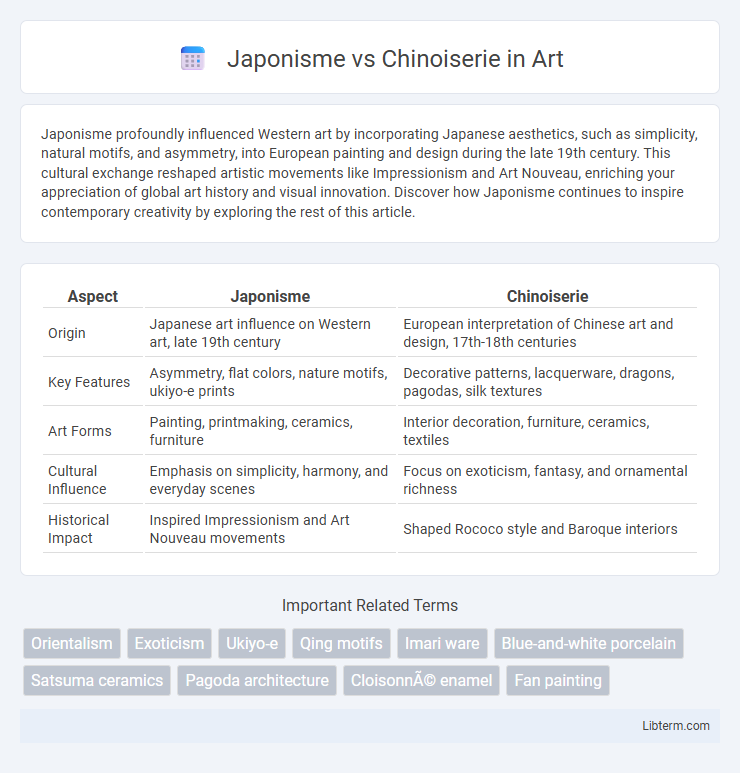Japonisme profoundly influenced Western art by incorporating Japanese aesthetics, such as simplicity, natural motifs, and asymmetry, into European painting and design during the late 19th century. This cultural exchange reshaped artistic movements like Impressionism and Art Nouveau, enriching your appreciation of global art history and visual innovation. Discover how Japonisme continues to inspire contemporary creativity by exploring the rest of this article.
Table of Comparison
| Aspect | Japonisme | Chinoiserie |
|---|---|---|
| Origin | Japanese art influence on Western art, late 19th century | European interpretation of Chinese art and design, 17th-18th centuries |
| Key Features | Asymmetry, flat colors, nature motifs, ukiyo-e prints | Decorative patterns, lacquerware, dragons, pagodas, silk textures |
| Art Forms | Painting, printmaking, ceramics, furniture | Interior decoration, furniture, ceramics, textiles |
| Cultural Influence | Emphasis on simplicity, harmony, and everyday scenes | Focus on exoticism, fantasy, and ornamental richness |
| Historical Impact | Inspired Impressionism and Art Nouveau movements | Shaped Rococo style and Baroque interiors |
Origins and Historical Background
Japonisme originated in the late 19th century as Western artists and collectors were captivated by the aesthetics of Japanese art following Japan's reopening to international trade in 1854. Chinoiserie emerged earlier in the 17th century during the European fascination with Chinese culture, heavily influenced by trade through the Silk Road and the arrival of Chinese goods in Europe. Both movements reflect the Western adaptation and romanticization of East Asian artistic traditions during periods of increased cross-cultural exchange and colonial expansion.
Defining Japonisme: Key Characteristics
Japonisme refers to the influence of Japanese art and design on Western culture, particularly in the late 19th and early 20th centuries, characterized by the use of asymmetry, flat color planes, and natural motifs such as cherry blossoms and cranes. This movement emphasizes simplicity, minimalism, and the integration of everyday objects as artistic subjects, reflecting a philosophical appreciation of nature and impermanence. Key features include ukiyo-e prints, delicate line work, and a preference for unconventional perspectives that contrast with the ornate and symmetrical elements found in Chinoiserie.
Understanding Chinoiserie: Essential Features
Chinoiserie is characterized by its intricate patterns, vibrant colors, and motifs inspired by Chinese art, including pagodas, dragons, and floral designs that emphasize asymmetry and natural forms. This decorative style often incorporates lacquerware, porcelain, and silk textures, highlighting the European fascination with East Asian craftsmanship during the 17th and 18th centuries. Key features also include stylized landscapes and whimsical, exotic elements that blend fantasy with traditional Chinese aesthetics.
Influences on Western Art and Design
Japonisme and Chinoiserie significantly shaped Western art and design during the 19th and early 20th centuries, introducing distinctive aesthetic elements from East Asia. Japonisme emphasized asymmetry, natural motifs, and simplicity drawn from Japanese ukiyo-e prints, influencing Impressionists like Claude Monet and decorative arts in Art Nouveau. Chinoiserie showcased intricate patterns, exotic themes, and vibrant colors inspired by Chinese porcelain and lacquerware, impacting Rococo interiors and European ceramics.
Iconic Artists and Designers
Japonisme, characterized by the influence of Japanese art on Western artists like Vincent van Gogh and James McNeill Whistler, emphasized natural forms, asymmetry, and bold color contrasts that transformed Impressionism and Art Nouveau. Chinoiserie drew inspiration from Chinese motifs and aesthetics, prominently showcased by designers such as Thomas Chippendale and Jean-Baptiste Pillement, integrating intricate patterns, lacquer work, and mythical imagery into Rococo and Baroque interiors. Both movements profoundly shaped the Western art and design landscape through their distinct cultural elements and iconic creators.
Motifs and Symbolism in Japonisme
Japonisme features motifs such as cherry blossoms, cranes, fans, and ukiyo-e woodblock prints that emphasize nature, fleeting beauty, and tranquility, reflecting Shinto and Zen Buddhist symbolism. The use of asymmetry, negative space, and delicate lines in Japonisme highlights simplicity and the ephemeral quality of life, contrasting with the often ornate and symmetrical patterns found in Chinoiserie. Symbolism in Japonisme conveys harmony between humans and nature, embodying concepts like impermanence (mono no aware) and peaceful coexistence, which deeply influenced Western art and design.
Patterns and Themes in Chinoiserie
Chinoiserie patterns feature intricate motifs inspired by Chinese art, including pagodas, dragons, florals, and exotic birds, often rendered with a whimsical and fantastical touch. Themes emphasize nature, mythology, and an idealized vision of East Asian culture, reflecting Western interpretations rather than authentic representation. These designs contrast with Japonisme's focus on minimalism, asymmetry, and natural elements such as cherry blossoms and ukiyo-e prints.
Cultural Impact and Popularity
Japonisme and Chinoiserie significantly influenced Western art and design during the 19th century, with Japonisme sparking a fascination for Japanese aesthetics following Japan's reopening to trade in the 1850s. Japonisme popularized elements such as asymmetry, natural motifs, and minimalist design in Impressionist and Post-Impressionist works, profoundly impacting artists like Vincent van Gogh and Claude Monet. Meanwhile, Chinoiserie, rooted in earlier European interpretations of Chinese art since the 17th century, remained popular in decorative arts and interior design, emphasizing ornate patterns and exoticism that reflected Western fantasies of Eastern culture.
Japonisme vs Chinoiserie: Aesthetic Differences
Japonisme emphasizes asymmetry, natural motifs, and subtle color palettes inspired by Japanese woodblock prints, while Chinoiserie features symmetrical designs, intricate patterns, and vibrant colors reflecting traditional Chinese porcelain and architecture. Japonisme favors simplicity and organic forms, contrasting with the ornate and decorative elements characteristic of Chinoiserie. These aesthetic differences highlight the distinct cultural influences and artistic philosophies behind each style.
Lasting Legacy in Modern Art and Decor
Japonisme and Chinoiserie have left a lasting legacy in modern art and decor by introducing distinctive aesthetic principles that continue to inspire contemporary design. Japonisme's influence is evident in minimalist compositions, asymmetry, and natural motifs, while Chinoiserie is recognized for its intricate patterns, lacquer finishes, and incorporation of Eastern symbolism. Both movements contributed to a cross-cultural exchange that shaped Western modernism and global interior trends.
Japonisme Infographic

 libterm.com
libterm.com